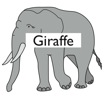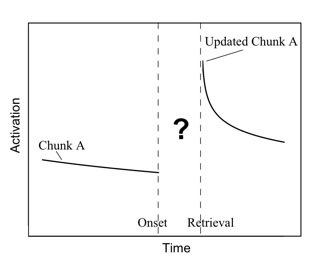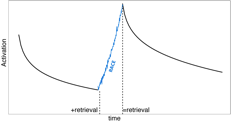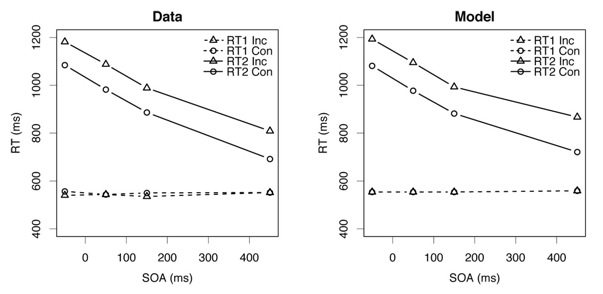ACT-R
ACT-R Spring School
08-04-10 08:39
Next week I will attend the ACT-R Spring School at the University of Groningen. I will teach a class and mentor researchers who come to Groningen to start new ACT-R research projects. In my lecture I will introduce the RACE/A declarative memory theory that has recently been proposed as an extension to ACT-R. RACE/A models enable researchers to include very detailed accounts of memory and decision-making processes in their ACT-R models. Sofar, the theory has been applied to make integrated ACT-R models of the Stroop effect, picture-word interference, learning and cognitive control related effects in semantic interference, and lexical decision.
After the Spring School, I will also present my recent work on the First European ACT-R Workshop. In this talk, I will discuss an experimental paradigm used in multiple-choice decision-making research, and present a model very much in line with RACE/A that may explain some complex interactions that we have observed in the paradigm.
After the Spring School, I will also present my recent work on the First European ACT-R Workshop. In this talk, I will discuss an experimental paradigm used in multiple-choice decision-making research, and present a model very much in line with RACE/A that may explain some complex interactions that we have observed in the paradigm.
Winner Best Student Paper at ICCM
27-07-09 20:18

The paper describes how cognitive control may determine not only the effect size of picture-word interference, but also the stage in a task in which the interference occurs. Using a RACE/A model we show that the apparent shift of the interference effect from a late to an early effect locus may be the result of a decrease of the cognitive control on reading the word (of the picture-word stimulus).
Speaker at ACT-R Workshop this summer
16-04-09 15:08
Next July I will speak at the ACT-R workshop that precedes the Annual Cognitive Science Conference in Amsterdam. The workshop will focus on recent developments in the cognitive architecture itself, and I will present our work on the memory retrieval theory RACE/A. The abstract of my talk is below.
In ACT-R’s declarative memory, each chunk has a certain activation level that determines the retrieval latency and the probability of retrieval for a chunk. For many cognitive modeling efforts, this information is precise enough to simulate memory processes. In some cases, however, a more fine-grained process model of declarative memory retrievals is required. For instance, information that becomes available during the retrieval of a chunk may affect the retrieval latency of that chunk. A prototypical example of this is the Stroop task. In the Stroop task, naming the color of a word that describes another color (e.g., the word “red” written in green letters) takes on average longer than naming the color of a neutral word (e.g., the word “dog” written in green letters). This is even the case if the color and the word are temporally separated (e.g., if the color word is presented after the color itself), which is difficult to explain with the default ACT-R declarative memory theory.

We developed an extension to ACT-R (called Retrieval by Accumulating Evidence in an Architecture or RACE/A, Van Maanen, 2009; Van Maanen & Van Rijn, 2007) that provides a specification of the activation dynamics during the declarative memory retrieval process. RACE/A describes memory retrievals as a sequential sampling process (e.g., Ratcliff, 1978). During a memory retrieval the activation of all chunks is continuously updated based on spreading activation from stimuli and other chunks in declarative memory. A chunk is retrieved if the activation of that chunk exceeds the activation of the others by a critical ratio (e.g., Luce, 1986). As a result, if the activation of multiple chunks increases simultaneously, the retrieval process will take longer. In the case of the Stroop task, spreading activation between the chunk representing the color and the color word causes both chunks to accumulate activation, leading to a longer retrieval process than if word and color are unrelated (e.g., “dog” and the color red), in which case there is no spreading activation.
In this talk, I will go into the principles underlying RACE/A, and I will provide examples of tasks that can be explained using RACE/A. RACE/A is available as a separate module for ACT-R (which can be downloaded from http://www.ai.rug.nl/~leendert/race). The module enables cognitive scientists to develop ACT-R models with a more fine-grained theory of declarative memory.
References
In ACT-R’s declarative memory, each chunk has a certain activation level that determines the retrieval latency and the probability of retrieval for a chunk. For many cognitive modeling efforts, this information is precise enough to simulate memory processes. In some cases, however, a more fine-grained process model of declarative memory retrievals is required. For instance, information that becomes available during the retrieval of a chunk may affect the retrieval latency of that chunk. A prototypical example of this is the Stroop task. In the Stroop task, naming the color of a word that describes another color (e.g., the word “red” written in green letters) takes on average longer than naming the color of a neutral word (e.g., the word “dog” written in green letters). This is even the case if the color and the word are temporally separated (e.g., if the color word is presented after the color itself), which is difficult to explain with the default ACT-R declarative memory theory.

We developed an extension to ACT-R (called Retrieval by Accumulating Evidence in an Architecture or RACE/A, Van Maanen, 2009; Van Maanen & Van Rijn, 2007) that provides a specification of the activation dynamics during the declarative memory retrieval process. RACE/A describes memory retrievals as a sequential sampling process (e.g., Ratcliff, 1978). During a memory retrieval the activation of all chunks is continuously updated based on spreading activation from stimuli and other chunks in declarative memory. A chunk is retrieved if the activation of that chunk exceeds the activation of the others by a critical ratio (e.g., Luce, 1986). As a result, if the activation of multiple chunks increases simultaneously, the retrieval process will take longer. In the case of the Stroop task, spreading activation between the chunk representing the color and the color word causes both chunks to accumulate activation, leading to a longer retrieval process than if word and color are unrelated (e.g., “dog” and the color red), in which case there is no spreading activation.
In this talk, I will go into the principles underlying RACE/A, and I will provide examples of tasks that can be explained using RACE/A. RACE/A is available as a separate module for ACT-R (which can be downloaded from http://www.ai.rug.nl/~leendert/race). The module enables cognitive scientists to develop ACT-R models with a more fine-grained theory of declarative memory.
References
- Luce, R. D. (1986). Response times. New York: Oxford UP.
- Ratcliff, R. (1978). A theory of memory retrieval. Psychological Review, 85(2), 59-108.
- Van Maanen, L. (2009). Context effects on memory retrieval: Theory and applications. Doctoral thesis, University of Groningen, Groningen.
- Van Maanen, L., & Van Rijn, H. (2007). An accumulator model of semantic interference. Cognitive Systems Research, 8(3), 174-181.
Cognitive Modeling on LinkedIn
01-11-08 09:43
In an attempt to create an online community of people interested in cognitive modeling, we started a Cognitive Modeling Group on LinkedIn. The group is intended at everyone who is interested in formal modeling of cognition. Frameworks of interest include cognitive architectures (e.g., ACT-R, Soar, or EPIC), Bayesian models, mathematical models, multi-agent models, connectionist models, etc.
Click the image to join!

(Also check out the Facebook group :-)).
Click the image to join!

(Also check out the Facebook group :-)).
Webpage on RACE
31-07-08 15:07

Download RACE Module
11-07-08 14:07
You can now download the RACE module for ACT-R! RACE (acronym for Retrieval by ACcumulating Evidence) is a new memory retrieval mechanism for ACT-R, that is capable of predicting the activation dynamics during the retrieval from memory. With RACE it is possible to model semantic intereference effects in ACT-R.
Download here the RACE module. The module has been tested for Lispworks 5.0 and ACT-R 6.0 . You need to have the old vision module installed (avaliable in the “extras” folder of the ACT-R distribution).
Update: RACE is now also available for the new vision module (download here).
Download here the RACE module. The module has been tested for Lispworks 5.0 and ACT-R 6.0 . You need to have the old vision module installed (avaliable in the “extras” folder of the ACT-R distribution).
Update: RACE is now also available for the new vision module (download here).
Presentation at CogSci2008
04-06-08 21:31
This summer I will present my research on the memory retrieval process at the Annual Cognitive Science Conference in Washington DC. The talk will be on a cognitive model with which we are able to account for remarkable latency differences in Stroop and picture-word interference tasks.

The figure displays the model’s fit to a Stroop data set (Fagot & Pashler, 1992 Experiment 7) under dual-task conditions. RT2 indicates the reaction times for the Stroop task. RT1 indicates the reaction times on another task that is performed concurrently. Inc and Con refer to the incongruent (RED) and congruent (RED) Stroop stimuli respectively.

The figure displays the model’s fit to a Stroop data set (Fagot & Pashler, 1992 Experiment 7) under dual-task conditions. RT2 indicates the reaction times for the Stroop task. RT1 indicates the reaction times on another task that is performed concurrently. Inc and Con refer to the incongruent (RED) and congruent (RED) Stroop stimuli respectively.
Retrieval by ACcumulating Evidence (RACE)
01-07-06 21:22
Retrieval by ACcumulating Evidence (RACE) is an extension to the ACT-R theory of cognition that can resolve the issues with declarative memory retrieval for symbolic theories of cognition such as ACT-R.
In RACE, retrieval of a chunk from declarative memory is thought of as a process in which evidence is accumulated for the likelihood that a chunk will be needed, similar to the idea underlying the leaky competing accumulator model (Usher & McClelland, 2001). The dynamics of the competition between memory chunks govern retrieval from declarative memory. Because RACE dynamically updates the activation values of chunks,it can explain interference effects observed in semantic memory retrieval better than existing ACT-R models.
Van Maanen & Van Rijn (2006) describe a model of picture-word interference (Glaser & Düngelhoff, 1984) in which RACE is used to explain latency effects observed in this task.
An R implementation of the picture-word interference model described by Van Maanen and Van Rijn (2006) can be downloaded here. After unzipping, check that the data file 'DM.Rdat' is in R's working directory. Type source("{directory-name}/PWImodel.r") in R and run the function diff.SOAs().
In RACE, retrieval of a chunk from declarative memory is thought of as a process in which evidence is accumulated for the likelihood that a chunk will be needed, similar to the idea underlying the leaky competing accumulator model (Usher & McClelland, 2001). The dynamics of the competition between memory chunks govern retrieval from declarative memory. Because RACE dynamically updates the activation values of chunks,it can explain interference effects observed in semantic memory retrieval better than existing ACT-R models.
Van Maanen & Van Rijn (2006) describe a model of picture-word interference (Glaser & Düngelhoff, 1984) in which RACE is used to explain latency effects observed in this task.
An R implementation of the picture-word interference model described by Van Maanen and Van Rijn (2006) can be downloaded here. After unzipping, check that the data file 'DM.Rdat' is in R's working directory. Type source("{directory-name}/PWImodel.r") in R and run the function diff.SOAs().
